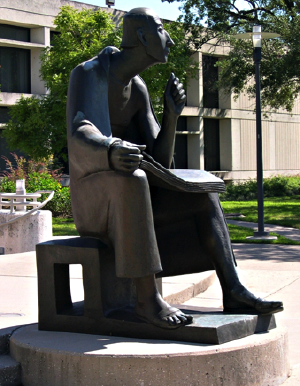By Richard Zagrzecki

Sitting quietly in front of the Law Center keeping a watchful eye on everyone who passes by is a seemingly harmless and fun-looking bronze statue of a Catholic saint by the name of Albertus Magnus.
It’s hard to believe that more than seven decades earlier, the German artist who created the piece was blacklisted by the Nazis during World War II, who declared his work “degenerate art,” confiscating and destroying much of it.
The Albertus Magnus statue was purchased by the University of Houston in 1970 and is now one of about 500 pieces that comprise the UH Public Art Collection. It was created 15 years earlier by Gerhard Marcks, a resident of Berlin who taught for 14 years at the Bauhaus art school in Germany until he was fired by the Nazis in 1933 and forbidden to make art or teach.
After the war was over, Marcks moved to Cologne, Germany, and rebuilt his life. That included returning to creating pieces of art. Marcks died in 1981 at the age of 92.
“Marcks suffered such persecution from the Nazis and loss from WWII bombings and his perseverance through it all is admirable,” said Michael Guidry, curator of the UH Public Art Collection. “We are so fortunate to have work by him in the Collection.”
Albertus Magnus, who died in 1280, was also known as Albert the Great and Albert of Cologne. He has been referred to as the greatest German philosopher and theologian of the Middle Ages.
The statue was the first piece of art bought by UH specifically to be placed in an outdoor setting. Now, 46 years later after its purchase, the campus landscape is dotted by a vast array of interesting and unique pieces.